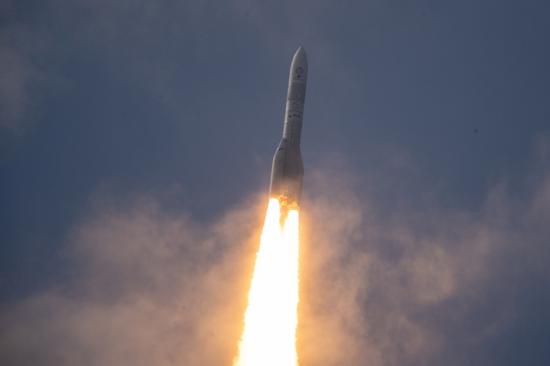New European rocket blasts off for 1st time
Europe's newest rocket, Ariane 6, successfully launched from French Guiana on the northern coast of South America on Tuesday.
Despite a one-hour delay due to a minor issue detected earlier, the rocket, developed at a cost of 4 billion euros ($4.3 billion), lifted off under clear weather conditions, according to the European Space Agency, or ESA.
The vehicle then climbed smoothly to its desired altitude, where it correctly released a number of small satellites.
Officials said the blast off marks a turning point for European space efforts, which had faced setbacks including a four-year delay in the rocket's development.
"It's a historic day for Europe," said Josef Aschbacher, director-general of the ESA.
"Europe is back," announced Philippe Baptiste, head of France's CNES space agency.
The mission encountered an unexpected challenge toward the end of its journey when the rocket strayed from its intended course, unable to execute its scheduled atmospheric re-entry and landing in the Pacific Ocean.
"It's a great success, despite the slight disappointment" at the end, said Walther Pelzer, head of Germany's DLR space agency.
Aschbacher added: "We're relieved; we're excited. This is a historic moment. The inaugural launch of a new heavy-lift rocket doesn't happen every year; it happens only every 20 years or maybe 30 years. And today we have launched Ariane 6 successfully."
Designed as a versatile and reliable launch vehicle, Ariane 6 aims to secure Europe's autonomous space access for both governmental agencies and commercial companies.
Future launches
Ariane 6 has booked 29 future launches, with many dedicated to putting Amazon's Kuiper internet satellites into orbit, reported the Agence France-Presse.
But concerns linger about its design potentially constraining its long-term viability in the evolving space industry, reported the BBC.
Following in the footsteps of its predecessor Ariane 5, the new model is designed as a single-use launch vehicle. This means each mission requires a brand-new rocket. In contrast, contemporary United States-produced spacecraft are being developed to be fully or partially reusable.
While Ariane 6 looks a lot like the older Ariane 5 on the outside, it is built with state-of-the-art manufacturing techniques, according to the ESA.
Europe plans to develop reusable rockets, but not until the 2030s. This means Ariane 6 faces challenges in the market.
Just weeks before the launch, EUMETSAT, Europe's weather satellite operator, unexpectedly switched from Ariane 6 to SpaceX's Falcon 9, citing "exceptional circumstances".
"We can all have our own opinions. What I can just reaffirm is that we have an order book that is full," said Lucia Linares, chief of space transportation strategy at the ESA. "I guess the word goes here to the customers: they have said Ariane 6 is an answer to their needs."

